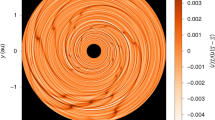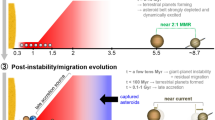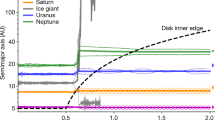Abstract
The ‘dynamically cold Kuiper belt’ consists of objects on low-inclination orbits between ∼40 and ∼50 au from the Sun. It currently contains material totalling less than a tenth the mass of the Earth1,2, which is surprisingly low because, according to accretion models3,4, the objects would not have grown to their present size unless the cold Kuiper belt originally contained tens of Earth masses of solids. Although several mechanisms have been proposed to produce the observed mass depletion, they all have significant limitations5. Here we show that the objects currently observed in the dynamically cold Kuiper belt were most probably formed within ∼35 au and were subsequently pushed outward by Neptune's 1:2 mean motion resonance during its final phase of migration. Combining our mechanism with previous work6,7, we conclude that the entire Kuiper belt formed closer to the Sun and was transported outward during the final stages of planet formation.
This is a preview of subscription content, access via your institution
Access options
Subscribe to this journal
Receive 51 print issues and online access
$199.00 per year
only $3.90 per issue
Buy this article
- Purchase on Springer Link
- Instant access to full article PDF
Prices may be subject to local taxes which are calculated during checkout



Similar content being viewed by others
References
Trujillo, C. A., Jewitt, D. C. & Luu, J. X. Properties of the Trans-Neptunian belt: statistics from the Canada-France-Hawaii telescope survey. Astron. J. 122, 457–473 (2001)
Gladman, B. et al. The structure of the Kuiper belt: Size distribution and radial extent. Astron. J. 122, 1051–1066 (2001)
Stern, S. A. & Colwell, J. E. Accretion in the Edgeworth-Kuiper belt: forming 100–1000 km radius bodies at 30 au and beyond. Astron. J. 114, 841–849 (1997)
Kenyon, S. J. & Luu, J. X. Accretion in the early Kuiper belt. I. Coagulation and velocity evolution. Astron. J. 115, 2136–2160 (1998)
Morbidelli, A. & Brown, M. E. The Kuiper belt and the primordial evolution of the solar system. In Comets II (eds Festou, M., Keller, H. U. & Weaver, H.) (Univ. Arizona Press, Tucson, in the press)
Gomes, R. S. The origin of the Kuiper belt high inclination population. Icarus 161, 404–418 (2003)
Malhotra, R. The origin of Pluto's orbit: implications for the Solar System beyond Neptune. Astron. J. 110, 420–432 (1995)
Jewitt, D. C. & Luu, J. X. Discovery of the candidate Kuiper belt object 1992 QB1. Nature 362, 730–732 (1993)
Brown, M. The inclination distribution of the Kuiper belt. Astron. J. 121, 2804–2814 (2001)
Levison, H. F. & Stern, S. A. On the size dependence of the inclination distribution of the main Kuiper belt. Astron. J. 121, 1730–1735 (2001)
Trujillo, C. A. & Brown, M. E. A correlation between inclination and color in the classical Kuiper belt. Astrophys. J. 566, 125–128 (2002)
Trujillo, C. A. & Brown, M. E. The radial distribution of the Kuiper belt. Astrophys. J. 554, 95–98 (2001)
Allen, R. L., Bernstein, G. M. & Malhotra, R. Observational limits on a distant cold Kuiper belt. Astron. J. 124, 2949–2954 (2002)
Ida, S., Larwood, J. & Burkert, A. Evidence for early stellar encounters in the orbital distribution of Edgeworth-Kuiper belt objects. Astrophys. J. 528, 351–356 (2000)
Weidenschilling, S. Formation of planetesimals/cometesimals in the solar nebula. In Comets II (eds Festou, M., Keller, H. U. & Weaver, H.) (Univ. Arizona Press, Tucson, in the press)
Hollenbach, D. & Adams, F. C. Dispersal of disks around young stars: constraints on Kuiper belt formation. In Debris Disks and the Formation of Planets (eds Caroff, L. & Backman, D.) (ASP, San Francisco, in the press)
Stone, J. M., Gammie, C. F., Balbus, S. A. & Hawley, J. F. in Protostars and Planets IV (eds Mannings, V., Boss, A. P. & Russell, S. S.) 589–612 (Univ. Arizona Press, Tucson, 1998)
Fernández, J. A. & Ip, W. H. Orbital expansion and resonant trapping during the late accretion stages of the outer planets. Planet. Space Sci. 44, 431–439 (1996)
Morbidelli, A. & Levison, H. F. Kuiper belt interlopers. Nature 422, 30–31 (2003)
Duncan, M. & Levison, H. A scattered disk of icy objects and the origin of Jupiter-family comets. Science 276, 1670–1672 (1997)
Luu, J. et al. A new dynamical class in the trans-Neptunian Solar System. Nature 387, 573 (1997)
Gomes, R. S., Morbidelli, A. & Levison, H. F. Planetary migration in a planetesimal disk: why did Neptune stop at 30 AU? Icarus (submitted)
Duncan, M. J., Levison, H. F. & Lee, M.-H. A multiple timestep symplectic algorithm for integrating close encounters. Astron. J. 116, 2067–2077 (1998)
Wisdom, J. & Holman, M. Symplectic maps for the n-body problem. Astron. J. 102, 1528–1538 (1991)
Hahn, J. M. & Malhotra, R. Orbital evolution of planets embedded in a planetesimal disk. Astron. J. 117, 3041–3053 (1999)
Acknowledgements
We are grateful to R. Gomes and M. Holman for acting as referees on this paper. We also thank L. Dones, W. Bottke, J.-M. Petit, and K. Tsiganis for help with an early version of the text and M. Duncan and R. Gomes for discussions. H.F.L. is grateful for funding from NASA. We thank the CNRS and NSF for encouraging friendly relationships between the US and France.
Author information
Authors and Affiliations
Corresponding author
Ethics declarations
Competing interests
The authors declare that they have no competing financial interests.
Rights and permissions
About this article
Cite this article
Levison, H., Morbidelli, A. The formation of the Kuiper belt by the outward transport of bodies during Neptune's migration. Nature 426, 419–421 (2003). https://doi.org/10.1038/nature02120
Received:
Accepted:
Issue Date:
DOI: https://doi.org/10.1038/nature02120
This article is cited by
-
Mass of the Kuiper belt
Celestial Mechanics and Dynamical Astronomy (2018)
-
All planetesimals born near the Kuiper belt formed as binaries
Nature Astronomy (2017)
-
Insights into Planet Formation from Debris Disks: I. The Solar System as an Archetype for Planetesimal Evolution
Space Science Reviews (2016)
Comments
By submitting a comment you agree to abide by our Terms and Community Guidelines. If you find something abusive or that does not comply with our terms or guidelines please flag it as inappropriate.



